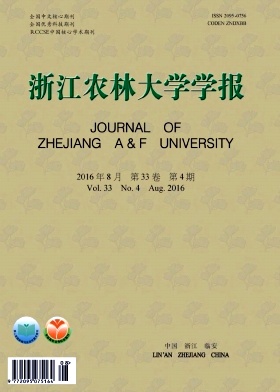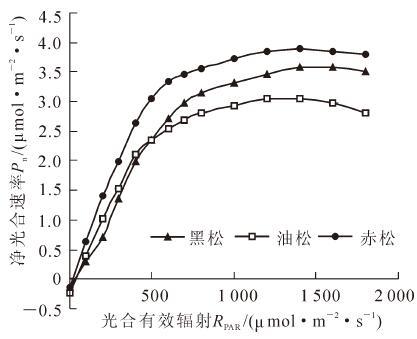-
进入21世纪以来,随着中国经济社会的发展,对森林的功能需求逐步由传统的木材生产转为生态效益、经济效益和社会效益的多功能需求。实行森林分类经营以后,对纳入生态公益林的现有人工林如何经营,一直是中国林业主管部门、科技工作者和森林经营技术人员思考和关注的重大问题[1-2]。人工林近自然经营理论的提出,为中国人工营造的生态公益林实现长期经营提供了有力的理论支撑[3-5]。通过合理抚育森林以促进森林天然更新,或通过人工林下播种或植苗方式实现林下更新,逐步将现有单层同龄纯林转化为异龄复层混交林,以达到人工林天然化经营的目的,从而实现对森林系统的长期经营。林下幼树更新是人工林近自然化过程中的关键。幼树阶段是个体生命周期中对环境影响最为敏感和最为脆弱的时期[6-7]。光作为影响植物生长的重要生态因子[8],因冠层结构和郁闭度的差异,导致森林群落下层出现大小不等的光斑和光强度,甚至光谱成分亦有差异,并且随时间呈现出动态变化。光辐射量的变化制约着幼树的更新、存活和生长[9-10],在树木生理特征上引起直接而迅速的响应。林下幼树的暗呼吸速率、光补偿点和光饱和点均随着光强的降低而降低[11-13]。光合原初反应和叶绿素荧光存在着密切关系,叶绿素荧光技术可以快速检测植株在胁迫下光合作用的真实行为,评价光合机构的功能和环境胁迫对它的影响。慢相荧光动力学参数主要揭示了光合暗反应启动后的光能利用和分配情况[14],而快相荧光动力学JIP测定技术可以分析光合作用的光反应过程和能量流程,并因其方便、快捷、无损、信息丰富等优点开始应用于植物光合功能的研究当中[15-16]。植物在弱光环境中叶绿素的慢相荧光动力学参数PSⅡ光化学效率、非光化学猝灭系数增加,光化学猝灭系数和电子传递速率逐渐降低[11, 17-19]。针对松属Pinus树种光合作用和叶绿素荧光动力学特征对梯度光强的响应尚缺乏必要研究,快相荧光动力学技术在光逆境下的研究还未见报道。本研究以华北地区山地森林生态系统中的主要针叶树种油松Pinus tabuliformis,黑松Pinus thunbergii,赤松Pinus densiflora等3个树种为研究对象,采用人工遮光的方法模拟旷地、林隙、林下3种不同的光照强度,对不同光强下3个树种幼树的光合生理特性和快相叶绿素荧光动力学特性进行了对比研究,探讨它们在不同光辐射下的光保护机制和光合机构的光反应过程,研究3个松属树种的天然更新能力与近自然森林经营的关系,揭示3个树种对梯度光环境的适应对策,从而为华北地区山地人工林的抚育和长期经营提供理论依据。
HTML
-
试验在山东农业大学南校区林学实验站(36°16′N,117°11′E)进行。该地区属于温带季风大陆性气候,四季分明,年均温为12.8 ℃,极端高温40.0 ℃,极端低温-20.0 ℃,≥10 ℃积温4 283.1 ℃,无霜期186.6 d,年降水量600~700 mm,降水分布不均匀,相对湿度65%。
-
试验材料为生长健壮的2年生实生油松、黑松、赤松营养袋苗,于2013年11月栽植于山东农业大学南校区林学试验站,2014年5月用黑色遮光网搭建遮光棚对供试材料进行遮光处理。遮光棚为东西向,高为2.0 m,南北开敞以便于通风透气。设置不遮光、1层遮光网覆盖、2层遮光网覆盖,形成不遮光对照,46%,81%不同遮光强度3种处理,分别模拟空旷地、林隙和林冠下生境光照条件。栽植苗木12株·小区-1,株距为30 cm,行距为50 cm,重复3次。遮光处理3个月后,于8月中旬进行光合和快相叶绿素荧光参数的测定。
-
在不遮光处理的油松、黑松、赤松幼树中,各选择3株·小区-1长势健壮均一的幼树,在当年新梢中部选择5束针叶,用配备针叶叶室[PP SYSTEMS PLC(C)]的便携式光合测定系统(CIRAS-2)对光响应曲线进行测定。控制大气二氧化碳摩尔分数400 μmol·mol-1,叶室温度24~26 ℃,相对湿度40%±5%,发光二极管(LED)光源控制光合有效辐射强度梯度为1 400,1 200,1 000,800,700,600,500,400,300,200,100,0 μmol·m-2·s-1。每个光照强度下设定数据采集时间为2 min,于晴天9:00-11:30进行测定。同时在不遮光处理、46%遮光处理和81%遮光处理的油松、黑松、赤松小区内各选择3株长势良好健壮均一的幼树,测定针叶叶片的净光合速率(Pn),蒸腾速率(Tr),胞间二氧化碳摩尔分数(Ci)和水分利用效率(EWUE),重复测定3次·株-1,LED光源控制光合有效辐射强度为1 200 μmol·m-2·s-1。用于光合作用参数测定的针叶采集后,放于自封袋,置于冰盒中带回,用EPSON PERFECTION V700 PHOTO根系扫描仪扫描针叶特征影像,应用根系分析软件WINzip获取针叶面积数据。净光合速率-光响应曲线在低光强(0~200 μmol·m-2·s-1)下呈直线部分的斜率即表观量子效率(EAQY),将测得的净光合速率(y)与相应的光量子(x)做直线回归y=a+bx,其中a为暗呼吸速率,b为表观光量子效率,a/b为光补偿点,即该直线与X轴的交点为其光补偿点(PLCP),与Y轴的交点则为光下的暗呼吸速率(Rd),光饱和点(PLSP)由抛物线模型y=ax+bx+c,以Pnmax时的光合有效辐射(RPAR)值计算。水分利用效率(EWUE)的计算公式为:EWUE =Pn/Tr。
-
采用Handy PEA(Plant Efficiency Analyser;Hansatech Instrument Ltd.,英国)测定3种松树在不同遮光处理下的快相叶绿素荧光参数。将针叶平铺在荧光夹中,覆盖住4 mm2的测试孔。暗适应20 min后,由650 nm的红光诱导,在3 000 μmol·m-2·s-1的饱和光强下,测定1 s,选取3株·小区-1长势一致的健壮幼树,重复测定3次·株-1。用PEA Plus V1.10专业软件对快相叶绿素荧光参数性能指数(Iabs),质体醌库的大小(Sm),PSⅡ捕获的能量从QA传递到QB的效率(ΨO),PSⅡ捕获的能量从QB传递到PSⅠ的效率(ΨRE),单位反应中心吸收的能量(ABS/RC),单位反应中心捕获的能量(TRo/RC),单位反应中心用于电子传递的能量(ETo/RC)进行整理。
1.1. 试验地概况
1.2. 试验材料与试验设计
1.3. 测定方法
1.3.1. 光合作用参数的测定
1.3.2. 快相叶绿素荧光参数测定
-
分析图 1和表 1可知:在全光照条件下,油松、黑松、赤松等3个树种的净光合速率均随着光合有效辐射量的增加呈现出大幅度增加的规律,到达一定程度后趋于平稳,达到光饱和点之后,随着光强的增加,净光合速率开始下降。最大净光合速率(Pnmax)反映了植物的生长速度。赤松最大净光合速率(Pnmax)最大,黑松次之,油松最小;暗呼吸速率(Rd)反映出在没有光照条件下的呼吸速率,暗呼吸速率呈现出油松>黑松>赤松的规律;光饱和点(PLSP)和光补偿点(PLSP)反映了植物利用强光和弱光能力的大小,黑松光饱和点最高,赤松光补偿点最低;表观量子效率(EAQY)反映了植物的耐荫性以及在弱光下吸收、转化和利用光能的能力,表观量子效率呈现出赤松>油松>黑松的规律。在3种松树中,赤松最大净光合速率最大,暗呼吸速率最小,光补偿点最低,表观量子效率最高,表明赤松对弱光的利用能力最强。
树种 拟合方程 线性方程 最大净光合速率(Pnmax)/(μmol·m-2·s-l) 暗呼吸速率(Rd)/(μmol·m-2·s-1) 光饱和点(PLSP)/(μmol·m-2·s-1) 光补偿点(PLCP)/(μmol·m-2·s-1) 表观量子效率(EAQY)/(mol·mol-1) 油松 y=-2x10-6x2+0.005 7x-0.230 8 (R2=0.958 3) y=0.006 3x-0.236 2 3.15 0.24 826 37.49 0.006 3 黑松 y=-3x10-6x2+0.007 1x-0.148 6 (R2=0.982 3) y=0.004 3x-0.142 4 3.76 0.14 1 596 33.12 0.004 3 赤松 y=-3x10-6x2+0.007 1x-0.128 6 (R2=0.957 0) y=0.00 7 7x-0.128 6 3.96 0.13 1 375 16.70 0.007 7 Table 1. Photosynthetic parameters of 3 pine species under 100% light regimes
-
分析图 2可知:光照条件的差异对黑松、油松、赤松的光合作用能力产生了不同的影响。3种松树幼树净光合速率(Pn),蒸腾速率(Tr),胞间二氧化碳浓度(Ci)及水分利用效率(EWUE)在不同光照条件下差异显著(P<0.05)。在全光照条件下净光合速率呈现出黑松>赤松>油松的规律,而在遮光条件下,油松>赤松>黑松;赤松蒸腾速率最大,随着遮光度的增加,油松的蒸腾速率大于黑松;全光照条件下水分利用效率呈现出黑松>油松>赤松的规律,46%遮光条件下赤松>油松>黑松,81%遮光条件下黑松和油松水分利用效率大于赤松。遮光度越高,黑松幼树的净光合作用能力越低,蒸腾速率与水分利用效率也随之降低,而胞间二氧化碳摩尔分数在46%遮光条件下>81%遮光>对照,净光合速率、蒸腾速率、胞间二氧化碳摩尔分数及水分利用效率均具有显著差异(P<0.05);油松幼树的净光合速率、蒸腾速率、胞间二氧化碳摩尔分数分别呈现出46%遮光>81%遮光>对照、81%遮光>46%遮光>对照、46%遮光>对照>81%遮光的规律,不同遮光条件下的水分利用效率差异不显著(P>0.05),46%遮光条件下利用率较高;赤松幼树的净光合速率和蒸腾速率在不同遮光条件下差异不明显(P>0.05),水分利用效率在46%遮光条件下利用率最高。从黑松、油松、赤松在不同光照条件下的光合特征参数的变化可以看出,黑松幼树对光强变化的适应能力强,但是不耐阴;油松幼树有一定的耐阴能力,在46%遮光条件下光合作用能力较强;赤松幼树耐阴性强,能够很好地在光合有效辐射量低的条件下生存。
-
叶绿素荧光可以从一定程度上反映环境因子对植物的影响,快相叶绿素荧光参数能够深入地揭示以PSⅡ为主的植物光合机构对环境的适应机制。遮光条件下PSⅡ反应中心及受体侧的变化及能量流动情况如表 2所示。性能指数Iabs反应光合机构的状态,黑松和油松的性能指数优于赤松,在0.05水平上差异显著。不同遮光条件下黑松的性能指数差异不显著(P>0.05),但随着遮光度的增加性能指数降低;油松的性能指数有显著的差异(P<0.05),在46%遮光状况下最大;赤松的性能指数差异不明显(P>0.05)。3种松树在遮光条件下,PSⅡ受体侧电子受体库(PQ)的容量(Sm)均变小,从QA-进入电子传递链的电子减少,黑松和油松变化差异明显,赤松无明显变化。黑松、油松和赤松PSⅡ捕获的能量从QA传递到QB的效率(ΨO)及PSⅡ捕获的能量从QB传递到PSⅠ的效率(ΨRE)差异显著(P<0.05),赤松PSⅡ捕获的能量从QA传递到QB的效率低于油松和黑松,但是PSⅡ捕获的能量从QB传递到PSⅠ的效率高于油松和黑松。遮光程度越大,黑松PSⅡ捕获的能量从QA传递到QB的效率和PSⅡ捕获的能量从QB传递到PSⅠ的效率越小;油松在46%遮光条件下效率最高;赤松的PSⅡ捕获的能量从QA传递到QB的效率和PSⅡ捕获的能量从QB传递到PSⅠ的效率不受遮光条件的影响。
树种 处理 Iabs Sm ψ0 ψRE ABS/RC TRo/RC ETo/RC 黑松 对照
46%遮光
81%遮光15.317±2.851 Aa
14.008±2.436 Aa
13.876±2.428 Ab22.383±1.583 Ab
21.288±1.960 Aa
16.793±0.729 Ba0.741±0.024 Aa
0.713±0.022 ABa
0.692±0.002 Bb0.187±0.018 Aa
0.180±0.012 Ab
0.136±0.006 Ba0.983±0.071 Ab
0.872±0.025 Ab
0.624±0.011 Aa0.933±0.023 Aab
0.784±0.004 Bab
0.566±0.030 Bab0.942±0.082 Aab
0.749±0.002 Bab
0.573±0.025 Ba油松 对照
46%遮光
81%遮光15.743±1.398 Ba
18.761±2.375 Aa
13.155±1.810 Ba31.881±0.763 Aa
23.692±0.605 Bb
21.645±1.727 Ca0.715±0.033 Ba
0.768±0.012 Aa
0.713±0.025 Ba0.199±0.035 ABa
0.217±0.017 Aab
0.177±0.014 Bb0.898±0.072 Bc
0.748±0.043 Bc
0.525±0.055 Bb0.950±0.077 Ab
0.804±0.012 Ab
0.614±0.008 Ab0.910±0.022 ABb
0.768±0.025 ABb
0.544±0.022 Ba赤松 对照
46%遮光
81%遮光12.220±2.153 Ab
11.862±1.679 Ab
12.288±0.550 Ab26.303±1.612 Aa
25.257±2.131 Aa
25.724±1.261 Aa0.722±0.026 Aa
0.710±0.027 Aa
0.712±0.012 Ab0.226±0.011 Aa
0.223±0.029 Aa
0.215±0.031 Aa1.092±0.054 Aa
0.914±0.041 Aa
0.694±0.016 Aa1.054±0.042 Aa
0.872±0.019 Aa
0.632±0.028 Ba1.019±0.062 Aa
0.859±0.047 Aa
0.629±0.033 Ba说明: 数据为平均值±标准差; 每一个参数中不同大写字母表示同一树种不同遮光处理间差异显著(P<0.05); 每一参数中不同小写字母表示不同树种间差异显著( P<0.05)。 Table 2. Effects on snapshot chlorophyll fluorescence parameters of 3 Pine species under different light regimes
3种松树在遮光条件下单位反应中心吸收的能量(ABS/RC),捕获的能量(TRo/RC)以及用于电子传递的能量(ETo/RC)有显著的差异(P<0.05)。赤松单位反应中心吸收、捕获及电子传递的能力均大于黑松和油松,PSⅡ光合机构对光能的利用能力最强。黑松单位反应中心对光能的吸收、捕获及利用能力在全光照条件下最强,随着光合有效辐射量的减小对光能的利用能力降低;油松在46%遮光条件下单位反应中心对光能的利用能力最强;光合有效辐射量的变化对赤松单位反应中心的光能利用效率无显著的影响(P>0.05)。快相叶绿素荧光参数结果表明:油松光合机构的状态以及PSⅡ反应中心捕获的能量在QA与QB间的传递效率优于黑松和赤松,但是赤松单位反应中心吸收及用于电子传递的能量均显著大于黑松和油松,能量利用效率高,致使PSⅡ捕获的能量从QB传递到PSⅠ的效率高。
2.1. 全光照条件下油松、黑松、赤松的光响应
2.2. 遮光对油松、黑松、赤松光合参数的影响
2.3. 遮光对油松、黑松、赤松快相叶绿素荧光参数的影响
-
植物最大净光合速率、暗呼吸速率、光饱和点、光补偿点以及表观量子效率的高低能够直接反映植物对弱光的适应性和捕获光量子用于光合作用的能力。植物的光补偿点越低,越有利于适应弱光环境,在弱光下进行光合作用,并且低光补偿点、高光饱和点的植物对复杂的光环境有更强的适应性。植物光合机构每吸收1 mol光量子进行光合作用后释放出的氧气的摩尔数或者同化的二氧化碳的摩尔数越高,则表观量子效率越高,植物吸收与转换光能的色素蛋白复合体越高,植物耐阴性越强[22-23]。最大净光合速率大则植物的净光合潜能大,生长速度快。暗呼吸速率小则代谢和生理活动消耗的光合产物少。本研究中,赤松幼树具有最低的光补偿点和暗呼吸速率、较高的光饱和点、最高的表观量子效率和最大净光合速率,因此,在黑松、油松和赤松3种树种当中,赤松苗木耐荫性强并且能够适应各种不同的光环境。
光照是影响植物净光合速率、蒸腾速率、胞间二氧化碳摩尔分数及水分利用效率的重要因素,不同植物对光强变化的响应特征不同。经过3个月的遮光处理,不同遮光条件下黑松、油松和赤松对光环境的反映有明显的不同。黑松的净光合速率、蒸腾速率与遮光程度呈现出负相关的关系,遮光强度越大,光合参数值净光合速率、蒸腾速率越小,体现植物在长期适应过程中为达到光合作用和蒸腾作用的最佳状态而形成的适应策略的水分利用效率也减少,弱光条件下气孔限制值降低,胞间二氧化碳摩尔分数升高,有利于二氧化碳的固定和植物对光能的利用率[24-25],然而净光合速率仍然下降,则捕获光合有效辐射量不足是遮光条件下光合速率下降的主要原因。油松的净光合速率、水分利用效率在46%遮光条件下最大,而蒸腾速率、胞间二氧化碳摩尔分数则随遮光程度增大而增大,可能是因为在全光照条件下,光抑制对光合反应中心造成一定的损伤,并且强光下细胞壁加厚影响气体交换速率以及呼吸速率增强[26],导致全光照条件下油松幼树光合能力并未明显高于46%遮光条件下的光合能力。赤松幼树因其光补偿点低,表观量子效率高,对弱光利用能力强,所以赤松的净光合速率、蒸腾速率在不同光环境中无显著差异。徐飞等[25]对麻栎Quercus acutissima,刺槐Robinia pseudoacacia光合特性对不同光照强度的响应结果表明,随遮光程度的增加,麻栎的净光合速率、蒸腾速率、气孔导度逐渐降低,刺槐的净光合速率则在适度遮光下最大。温达志等[27]对黧蒴Castanopsis fissa和九节Psychotria rubra的研究表明:与全光照相比,遮光下植物叶片净光合速率、气孔导度、胞间二氧化碳摩尔分数与大气二氧化碳摩尔分数之比变化不明显。因此,在不同光照条件下生长的植物,光合速率的变化与植物的种类及其所处的环境有关,并且呈现出不同的变化规律。
光环境的变化不仅影响植物的光合与蒸腾,还引发植物光合机构的能量流动和电子传递的变化,从而导致植物光合机构功能异常。天线色素(Chl)吸收的能量(ABS)一部分以热能和荧光(F)的形式耗散掉,另一部分被反应中心(RC)捕获(TR),反应中心的激发能转化成还原能之后将QA还原成QA-,QA-被重新氧化产生电子传递(ET),传递的电子用于固定二氧化碳或其他途径。黑松、油松和赤松幼树在遮光条件下单位反应中心吸收的能量(ABS/RC),捕获的能量(TRo/RC)以及用于电子传递的能量(ETo/RC)的不同,引起3种松属树种在弱光下对光响应机制的差异。赤松幼树在全光照、46%遮光及81%遮光条件下单位反应中心吸收、捕获以及用于电子传递的能量大于黑松和油松,并且差异显著(P<0.05),赤松的电子传递效率(ETR)高,利用弱光的能力强。随着生长光强的减弱,黑松单位反应中心吸收、捕获以及用于电子传递的能量值降低,表明遮光降低了黑松叶片PSⅡ光合电子传递活性,遮光条件下黑松单位反应中心吸收的能量没有明显减少,但是单位反应中心捕获的能量以及用于电子传递的能量值显著降低(P<0.05),因此,热耗散掉的能量比例升高,为碳同化积累的能量减少,这可能是黑松对弱光适应的一种保护机制,与刘建锋等[11]对遮光条件下崖柏Thuja sutchuenensis的叶绿素荧光动态变化情况相同。油松在全光照条件下过剩光能导致PSⅡ光反应中心关闭,而在46%遮光条件下单位反应中心吸收、捕获以及用于电子传递的能量值增大,说明遮光导致PSⅡ光反应中心开放度增加。遮光处理能够导致PSⅡ反应中心活性下降,电子传递过程受到抑制,同化力供应不足,植物的光合碳同化能力被限制。PSⅡ和PSⅠ在电子传递体PQ、细胞色素b6f复合体与质蓝素的协同作用下完成植物光合作用[28],PSⅡ捕获的能量从QA传递到QB的效率(ΨO)及PSⅡ捕获的能量从QB传递到PSⅠ的效率(ΨRE)的变化表明了电子在QA,QB及PSⅠ间的传递状况。黑松幼树在弱光条件下PSⅡ捕获的能量从QA传递到QB的效率及PSⅡ捕获的能量从QB传递到PSⅠ的效率减小,PSⅡ受体侧功能破坏,QB向PSⅠ的电子传递受到抑制,而QB作为光合电子传递过程中含量最多的电子传递体,因它们既传递电子,又传递质子的特异性,成为光合电子传递的关键步骤和限速环节,因而QB的活性被抑制,影响到PSⅠ正常的生理功能,最终致使光合作用能力下降[15-16]。
综上所述,黑松、油松和赤松幼树在弱光下的光响应和叶绿素荧光响应状况不同。赤松幼树光补偿点低、表观量子效率高、净光合速率高、PSⅡ反应中心对电子的传递能力强,对弱光的利用能力强,在旷地、林隙、林下不同光照强度条件下均能较好地生长。黑松幼树在弱光条件下净光合速率和PSⅡ反应中心活性均降低,电子传递过程受抑制,光合作用能力减弱。黑松在林隙及林下照光不充足的环境中难以保持良好的生长状态,因此,黑松幼树适宜在旷地生存。强光抑制油松PSⅡ反应中心的开放度,在轻度遮光条件下光合作用能力最强,油松适宜在林隙环境中生存。在黑松、油松、赤松等3种松属树种人工林近自然化经营过程中,应当分别选取不同的择伐方式,为其提供适宜幼树天然更新的光环境条件,以保持森林最基本的自然结构特征,从而使森林的生态功能最大程度地发挥出来,为国家的社会发展奠定坚实的生态环境基础。









 DownLoad:
DownLoad:
